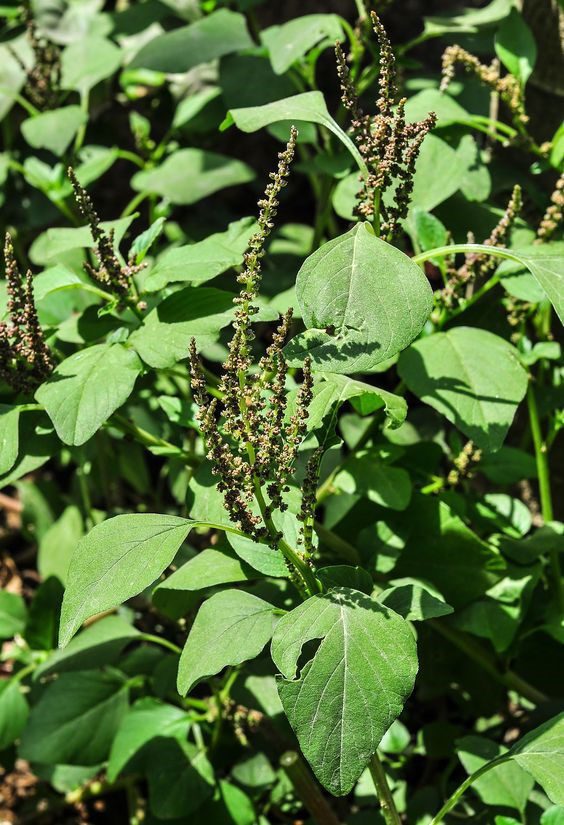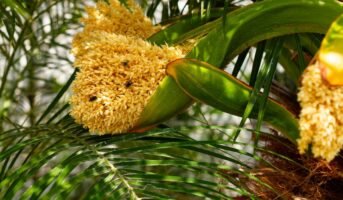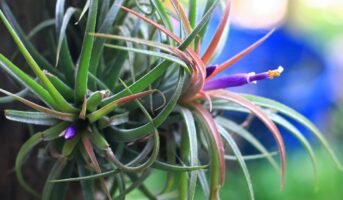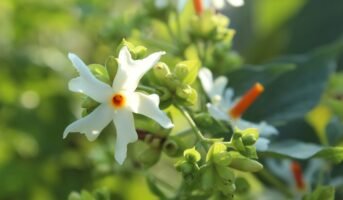Slender amaranth, sometimes known as green amaranth, is the common name for the species Amaranthus viridis, which belongs to the plant family Amaranthaceae and is found all over the world.
The greens of the amaranth plant are also known as Chinese spinach. It is a nutrient-rich green vegetable that is consumed all across the nation in the forms of stir-fries, soups, gravies, recipes that are cooked for a longer period of time, daal, and curries. Herbs belonging to this worldwide genus can be found in a range of colours, including red and green or even bicoloured varieties.

Source: Pinterest
Green amaranth: Key facts
| Biological Name | Amaranthus viridis |
| Common Name | Green amaranth, slender amaranth, Chinese spinach |
| Family | Amaranthaceae |
| Maximum Height | 4 ft |
| Soil pH | Neutral Acidic |
| Native Area | India, Africa & Peru |
| Bloom Time | Summer, Fall, Winter |
| Sun Exposure | Full Sun to Partial Shade. |
Green amaranth: The Genus
Amaranthus viridis or the green amaranth is an annual growing herb from the Amaranthaceae family. It belongs to the Amaranthus genus and characterised by an upright, light green stem. Some plants of the amaranth species are grown as leaf vegetables, pseudocereals, and ornamental plants.
Green amaranth: Native habitat
Green Amaranth is known to have originated in the eastern United States. Traditionally, it is a tropical plant, which also grows across India, south Asia, and Mexico.
Green amaranth: Features
- Amaranthus viridis is an annual herb that may grow to a height of approximately 60–80 centimetres and has an erect stem that is light green in colour.
- The base of the plant produces a large number of branches, and the leaves are ovate in shape, ranging from 3 to 6 centimetres in length and 2 to 4 centimetres in width, and the petioles are around 5 centimetres in length.
- Small green blooms with three stamens each may be seen on the plant’s terminal panicles, which have very few branches.
Green amaranth: Growing tips
- When planting amaranth seeds outside, you should leave approximately four inches of space between each seed and just cover them with dirt when the earth has warmed up in late April.
- In most cases, the germination process takes between 7 and 14 days. As the seedlings begin to grow, you should space them 10 to 18 inches apart.
- When beginning seeds inside, you may use a basic seed-starting mix and put seeds around 6-8 weeks before your normal last frost date. This will give the seeds enough time to develop and grow. A temperature of around 60 degrees Fahrenheit should be maintained at all times, and the seeds should be kept gently covered.
- After the seeds have germinated, the plants should be moved into an area with enough light so that they may continue developing there until they are mature enough to be transplanted outside.
- Before transplanting the seedlings into the garden, you should make sure to harden them off first, so they are ready for the circumstances.
- Before properly putting the seedlings outside, the average temperature of the surrounding air must first reach around 55 degrees Fahrenheit.
- Amaranth plants can easily spread their own seeds around the yard due to the abundance of seeds produced by each plant.
- When the volunteer seedlings begin to emerge in the spring, you may either space them out to a distance of around 10 to 18 inches or gently dig them up and transplant them somewhere else.
- In addition, it is feasible to gather seeds in the autumn and then sow them in the spring of the following year.
Green amaranth: Maintenance tips
- In the cooler northern portion of its area, amaranth thrives best in partial shade throughout the day, whereas in the warmer southern parts of its habitat, it performs best in full sun.
- Plant amaranth in a location that enjoys sunlight for at least six hours every day since this is the optimal amount of light for the plant.
- Amaranth does best in soils on the ordinary side, but it may also grow satisfactorily on soils on the bad side.
- Only extremely deep clay combinations are likely to be fully incompatible with amaranth; nonetheless, extremely rich soils may prevent flowering and the formation of seeds.
- Plants grown from amaranth have medium watering requirements, requiring no more than one inch of water each week. If you overwater them, you run the danger of root rot and fungal illnesses. Take care not to do so.
- Amaranth thrives at high temperatures, in contrast to many other types of leafy green crops.
- There are a lot of different species that are indigenous to the southern United States and Mexico, and because of this, you can anticipate that they will do well even when the temperatures are particularly high.
- Amaranth does not need any additional nutrients added to its diet.
- An excessive amount of nitrogen, which is typically present in fertilisers, might cause the plants to grow lanky, making them less appropriate for harvesting.
Green amaranth: Uses
- In several regions of the world, green amaranth is consumed as a cooked green or a vegetable.
- It is known as Cheng Kruk in the northeastern Indian state of Manipur and as kuppa cheera in the southern Indian state of Kerala, where it is used as a vegetable. Shak is the usual name for this vegetable in Bengali cooking.
- It is a popular vegetable used in Odia cuisine called Saaga, namely Kosila Saaga or Marshi Saag in the countryside.
- It is also consumed as a vegetable in areas of Africa. The Dhivehi word massaagu refers to the leaves of this plant, which have been used as a part of the Maldivian cuisine for ages, particularly in mas huni.
- This plant is called Ewe Tete by the Yoruba of West Africa and is utilised for medical and spiritual purposes.
- Next to spinach, it seems to mostly resemble nettle leaves cooked in water, which, when young, are eaten in England and are considered to be delicious.
- This amarantus should be prepared similarly to spinach. As it gets more well-known, it is guaranteed to become popular, with the notable exception of those who are allergic to it and those who consider it beneath their dignity to eat nettles.
- Under the Sanskrit name Tanduliya, Amaranthus viridis is utilised as a therapeutic plant in ancient Ayurvedic medicine.
- Amaranth green can contain as much as 38% protein by dry weight. The leaves and seeds contain the essential amino acid lysine.

Source: Pinterest
FAQs
Is amaranth hard to grow?
Amaranth is fairly simple to cultivate.
How long does amaranth take to grow?
Green amaranth takes three months to grow.
Housing News Desk is the news desk of leading online real estate portal, Housing.com. Housing News Desk focuses on a variety of topics such as real estate laws, taxes, current news, property trends, home loans, rentals, décor, green homes, home improvement, etc. The main objective of the news desk, is to cover the real estate sector from the perspective of providing information that is useful to the end-user.
Facebook: https://www.facebook.com/housing.com/
Twitter: https://twitter.com/Housing
Email: [email protected]











